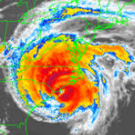All Activity
- Past hour
-

Hurricane Erin: 110 MPH - 943 mb - N @ 13
NorthHillsWx replied to BarryStantonGBP's topic in Tropical Headquarters
Family at nags head reports no overwash and very breezy conditions. Seems like highway 12 south of Oregon inlet took a beating like usual. -
I’m just going by the two gauges near me. Gotta unclog the stupid Davis.
-
Currently 55 degrees with sheets of drizzle. Loving it. Feels like October out there. Picked up .61" rainfall thus far. Would have liked more but I'll call it a win. With the cooler temperatures the .61" will "last" longer than if we bounced back to sunny and 90. I swear things look greener even with just .61".
-
Another reason that the high temperatures in desert cities can be similar or cooler to the outlying areas is due to something called the urban cooling island. It’s another reason greening urban desert cities is so important. Since it can lead to a 2C cooling inversion during the day. https://agupubs.onlinelibrary.wiley.com/doi/full/10.1002/2015GL066534 During the day, downtown areas appear to be cooler than the suburbs in six cities out of eight: Abu Dhabi, Kuwait City, Las Vegas, Phoenix, Biskra, and Bikaner, with values ranging from the −5.33°C in Abu Dhabi to the −0.06°C in Las Vegas during the summer. This effect can be partially explained considering that bare soils (prevalent in the suburbs) absorb more sunlight than urban surfaces due to their low reflectivity, hence leading to the relatively higher temperature of suburban areas [Georgescu et al., 2011]. This thermal gradient between the city center and suburbs can become even more pronounced when irrigated vegetation is present in the urban sites, resulting in heat advection, subsidence, and strong latent heat fluxes over the city. Also, the gradient can be modulated through the local wind regime and larger-scale atmospheric circulation alike, resulting in additional surface temperature variability across the diverse cities [Oke, 1987]. SUHI values referred to urban + vegetation sites are, in general, lower than the ones for the downtown sites, resulting in a further reduction of the temperature from few tenths of degrees to the −2.36°C in Phoenix at day in summer. It is, in fact, during the summer that the difference between urban and suburbs testing sites becomes wider: this phenomenon may be connected with intensive urban irrigation, eventually resulting in a sharp decoupling between vegetation and precipitation and to a lowering of the effects of heat stress on plants [Jenerette et al., 2013]. An exception is here represented by Bikaner, where from June to August, the southwestern monsoon carries sporadic spells of intense precipitation, which lower more easily the temperatures in bare and “permeable” suburban substrates than in “impervious” man-made surfaces [Kharol et al., 2013]. In agreement with previous results [Lazzarini et al., 2013; Lazzarini and Ghedira, 2014], Abu Dhabi displays the sharpest UCI effect, probably associated with the fact that it is located on an island [Frey et al., 2006; Wulfmeyer et al., 2014] and that the strong sea breeze regime triggered by monsoonal winds during the summer can induce a significant reduction of the atmospheric boundary layer depth, with a consequent mitigation of sensible heat fluxes along the coast [Eager et al., 2008]. In contrast, Riyadh and Doha do not show any inversion effect in the UHI, although the summer SUHIs have lower values than the winter ones on average. Again, this is consistent with previous results [Gamo, 1996; Alghamdi and Moore, 2014; Hashem and Balakrishnan, 2014; Sasidharan et al., 2009] and could be a consequence of the scarce vegetation coverage in these two cities (landscaping activities are limited) and urban design [Alghamdi and Moore, 2014]. During the night, however, the classical UHI phenomenon is restored: bare soil surfaces cool down faster than man-made and vegetated surfaces, resulting in strong positive SUHI values across all the cities of the ensemble. Therefore, HDCs are not immune from the UHI effect but rather oscillate between a diurnal UCI effect and a classic UHI at night. Since only two cities (Abu Dhabi and Kuwait City) out of the six displaying this diurnal UCI/nocturnal UHI alternation are close to a water body, breezes do not seem to have a dominant role in determining these common patterns, albeit additional local forcing on fluxes could arise from mild slopes and anabatic/katabatic flows [Yoshino, 1984; Rendón et al., 2014; Chemel et al., 2008; Sun et al., 2009; Brazel et al., 2010]. Nonetheless, proximity to the sea remains an important factor in reducing temperature ranges (see, e.g., the case of Abu Dhabi, Doha, and Kuwait City). In contrast, vegetation abundance and typology could be among the main causes of UCI. Transpiration patterns, in fact, largely depend on photosynthetic pathways: in C3 and C4 plants, for example, transpiration predominantly takes place during the day [see Caird et al., 2007, and references therein], while in Crassulacean acid metabolism (CAM) plants carbon uptake mainly occurs at night, under condition less conductive to water loss via transpiration [Bartlett, 2014]. Day/night ranges in the downtown sites appear smaller than the ones in the suburbs, while the ranges at the different sites tend to be amplified during the summer, with the exception of Bikaner, where again the precipitation events associated to the Indian summer monsoon could play an important role in modulating suburban LSTs. These features can be explained considering the lower heat capacity of suburban bare soils, allowing for quick variations of temperature. Owed to the decoupling with precipitation, the seasonal variability of NDVI within urban areas is extremely weak. However, during the summer, the elevated temperatures characterizing the HDCs can still trigger intense water stress in urban vegetation [Julien et al., 2011], leading to a summer reduction of the vegetation coverage in general, in contrast with what is generally observed in temperate regions. Following Zhou et al. [2013], Figure 2 shows the SUHI seasonal cycle evolution for day (Figure 2a) and night (Figure 2b). SUHI is calculated both as the difference in LST between urban + vegetation and the suburbs sites (green lines and symbols) and between downtown and the suburbs (in red). Observations are marked with light dots (grey for SUHI(Dt) and green for SUHI(U + V)), while monthly average values are indicated by black triangles (SUHI(U + V)) and filled circles (SUHI(Dt)), and the corresponding standard deviation of LST and SUHI is represented in the form of horizontal and vertical error bars. Thick continuous lines represent the SUHI(U + V) and SUHI(Dt) seasonal cycle after band-pass filtering of fine temporal scales up to 1 week with a Morlet wavelet of central frequency ω0=6 [Mallat, 2008]. The SUHI seasonal dynamics still displays clear diurnal UCI signature, and urban + vegetation sites show the highest potential for cooling in HDCs. However, the seasonal evolution of the SUHI strongly varies from city to city, pinpointing how not a single factor but rather the interplay between urban form, vegetation abundance, and local to regional climatic forcing are ultimately driving the thermal regimes of these cities. Also, the role of vegetation is not always univocal: in Biskra during the day, and in Phoenix at night, urban + vegetation sites appear to be warmer than their downtown counterparts. In both cases, the urban + vegetation test sites are located on a mild slope, facing north in the case of Biskra and southwest in the case of Phoenix. The topographic slope and the exposition to sunlight during the day could play a more prominent role than the sole vegetation coverage in these two cases. In Phoenix, for example, the urban + vegetation test site could be affected at night by a thermal belt effect [Yoshino, 1984], otherwise absent in the downtown site at the bottom of the valley, more likely subject to katabatic flows. It is also clear that in the presence of extended urban vegetated areas, plants phenology, irrigation systems, and specific microclimatic conditions can all contribute to the evolution of the SUHI. We performed a comparative analysis of the SUHI effect of cities located in hot desert environments (HDCs) using satellite data processing techniques. The main aim was to identify common patterns in the thermal regime of HDCs, testing at the same time the occurrence of the UCI effect observed in single studies dedicated to arid land cities. During the day, an average SUHI inversion of around 2°C was confirmed in six cities from a pool of eight. This inversion has been often associated with the abundance of irrigated vegetation in HDCs, which creates large areas where surface temperatures are mitigated through evaporative cooling. Despite that, the night LST analysis showed the standard UHI effect in all the cities. During the year, the variation of LST mainly showed a biseasonal mode, with a more evident inversion of SUHI during summer months. A comparative analysis of how the percentage of NDVI/ISA relates to LSTs also highlighted how medium dense urban sites with dedicated green areas are the ones showing the highest SUHI inversion probably due to the combined effect of shadowing and plant transpiration. However, all the cities displayed peculiar characteristics, pointing out how specific microclimatic and aridity conditions need to be taken into account in the SUHI assessment. Surface energy balance can be retrieved, and further variables (i.e., surface roughness and wind data) can be added to the picture, in order to better understand the microclimate of cities located in hyperarid regions. Seasonality of vegetation is expected to have a marginal role in HDCs due to the decoupling of vegetation from precipitation through irrigation [Jenerette et al., 2013]. In contrast, the typology of vegetation (C3, C4, or CAM) used in the landscaping could play a crucial role in mitigating (or reversing) UHI effects in desert cities. Also, the role of different irrigation strategies, as well as the link with desalination and its potential long-term impacts, needs to be addressed.
-
You gotta be near normal on the month now for water? Like 4”? Impressive if it only rains 2-3 days ha.
-
Record cold max temps for Hartford and Worcester yesterday. Second place finishes for Providence and Boston. Cold of yore.
-
Mid to long range discussion- 2025
WinstonSalemArlington replied to wncsnow's topic in Southeastern States
I love it how Van Denton and Fox 8 Triad have a 12-day forecast -
Brokeback
-
.42 in Weymouth and surrounding area on Cocorahs .99 here
-
Not quite. .78
-
E PA/NJ/DE Summer 2025 Obs/Discussion
pl0k00n111 replied to Hurricane Agnes's topic in Philadelphia Region
Nice break for the AC. -
1.67” Let’s get deep summer back
-
Radar estimated 0.80”
-
Wrong. Misty drizzle light rain type stuff out there, 1.70” now.
-
2025-2026 ENSO
PhiEaglesfan712 replied to 40/70 Benchmark's topic in Weather Forecasting and Discussion
If that happens, then any hope for an active Atlantic hurricane season is over. The next 2+ weeks puts us into September, which is the heart of the hurricane season. If it's a snooze fest, then there's a good chance Erin was a one-off (like Andrew in 1992). -
Only 0.20” MTD at CON and the rest of the month looks dry. Driest on record is 0.06” in 1996, but maybe #2 is still in the cards?
-
When’s landfall?
- Today
-
Few hundredths overnight
-
Not really a surprise but the tropical Atlantic looks to become a total snooze fest for the next 2+ weeks
















